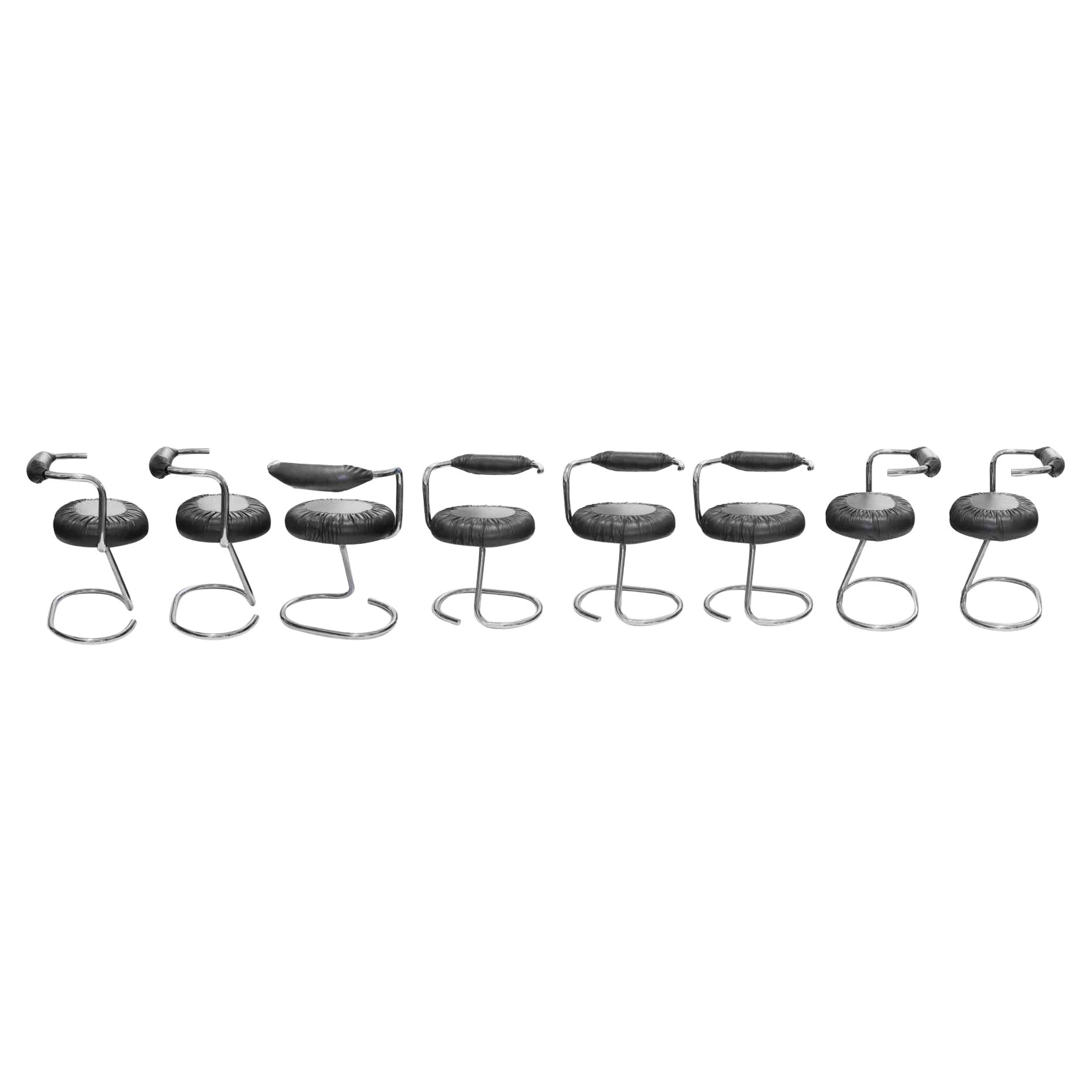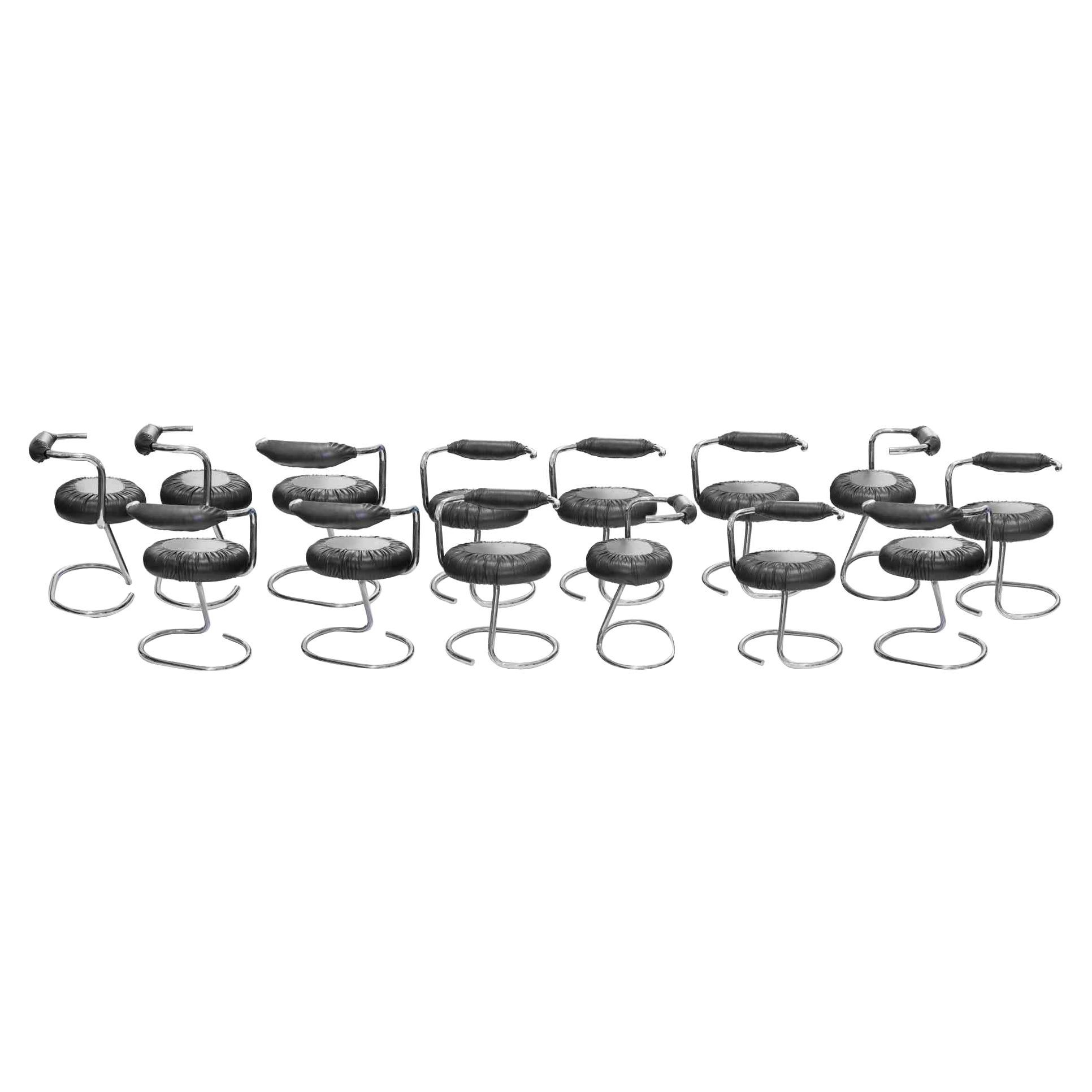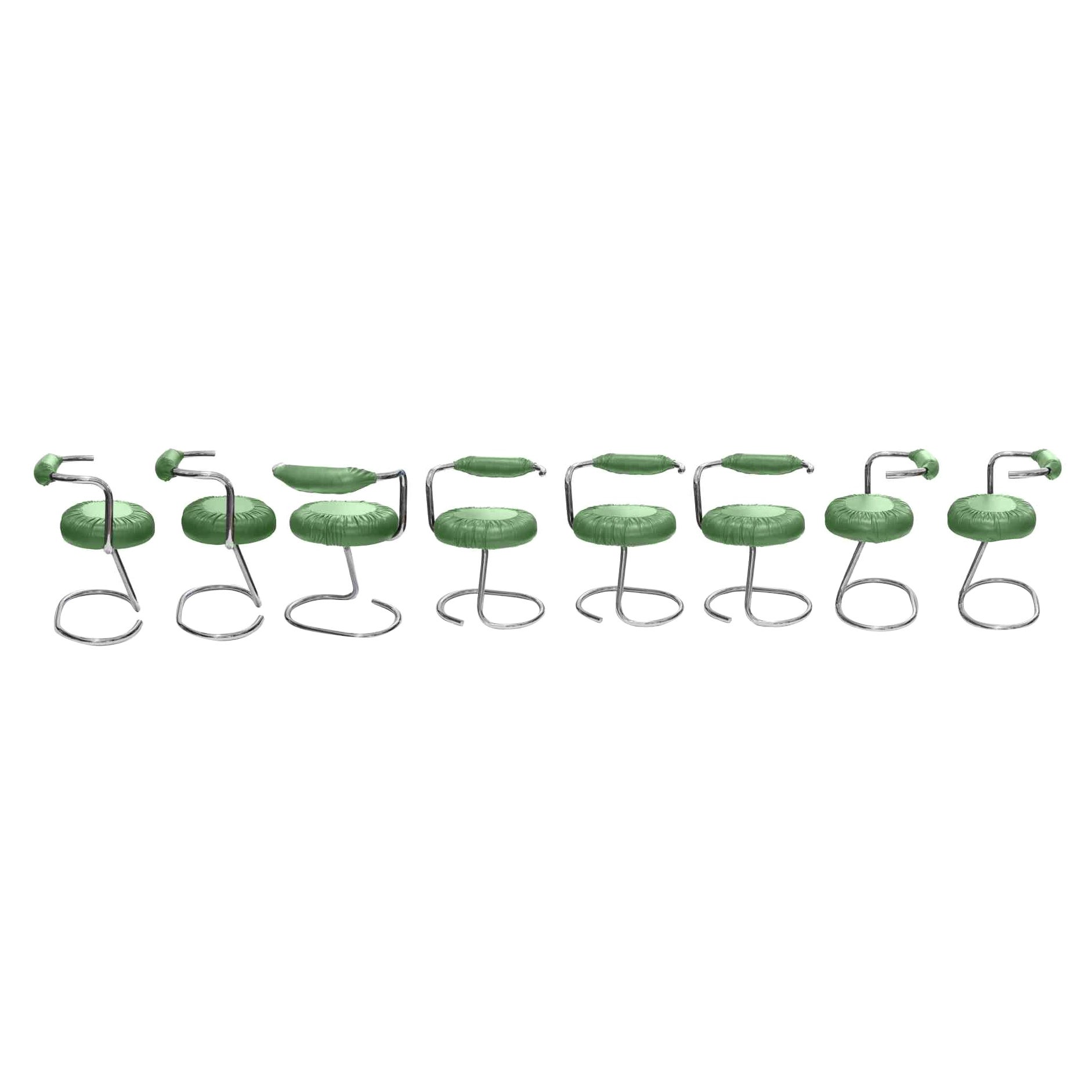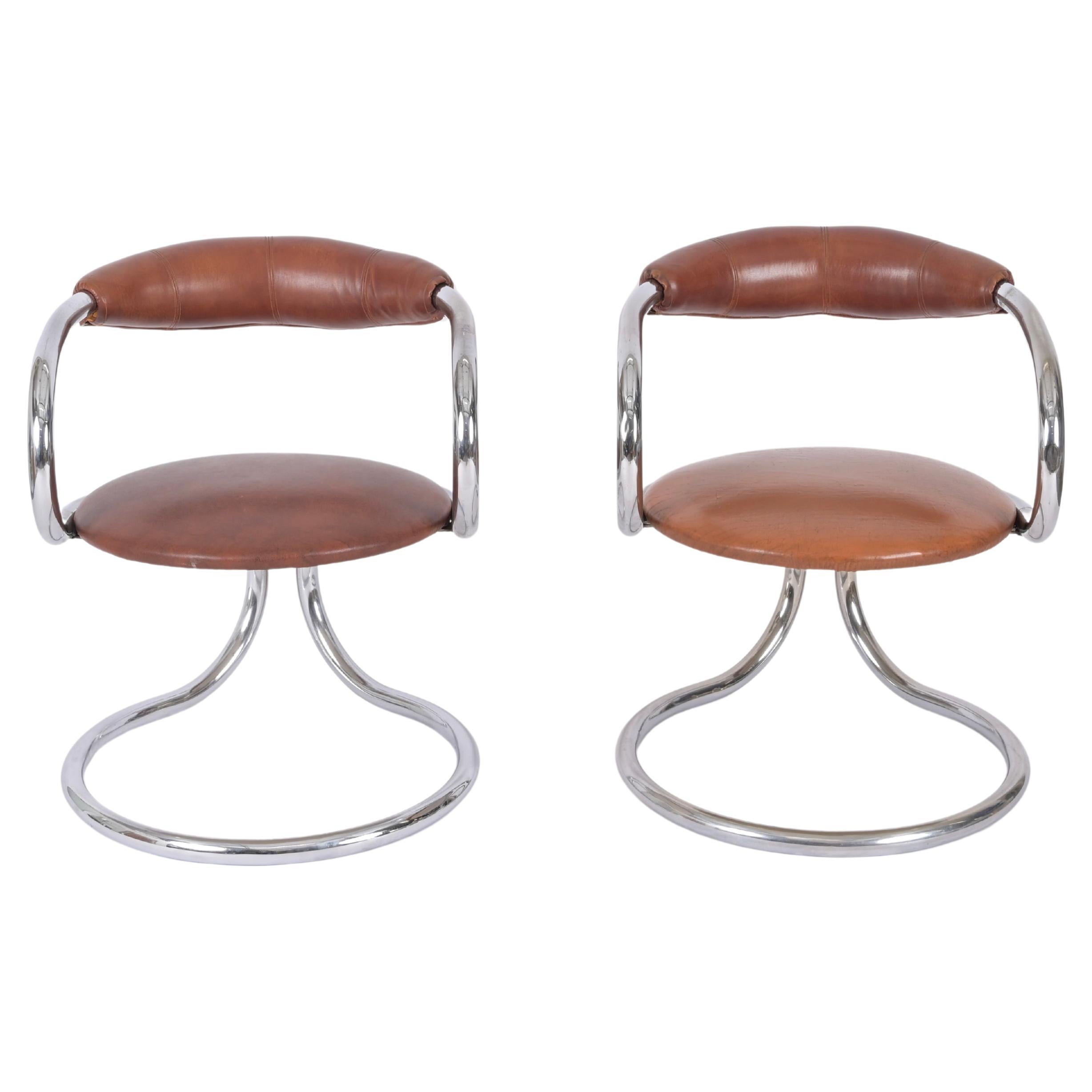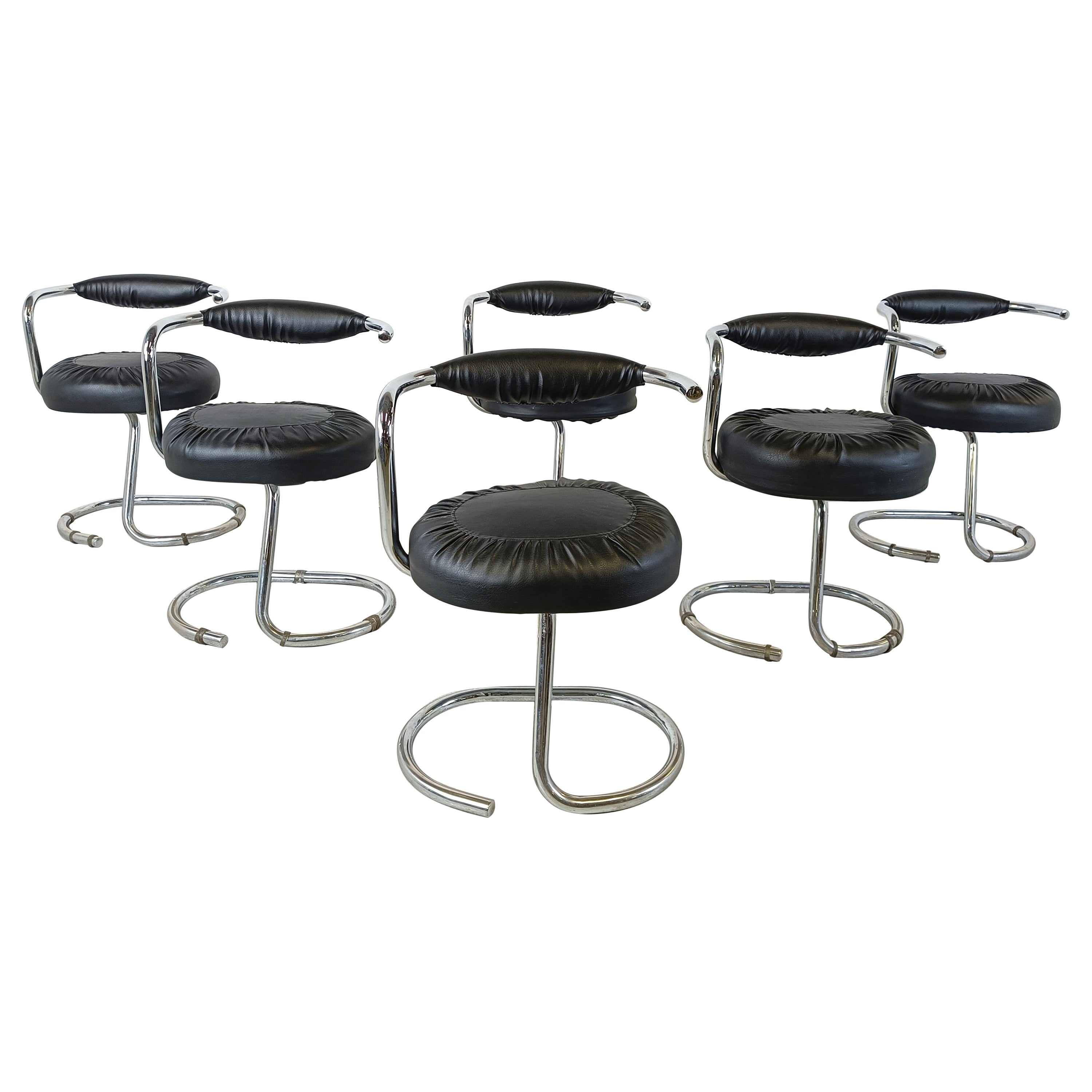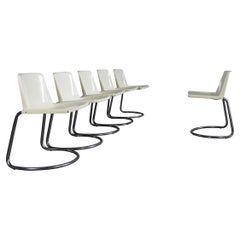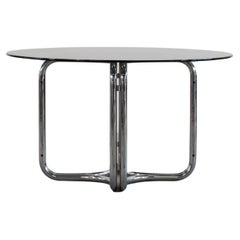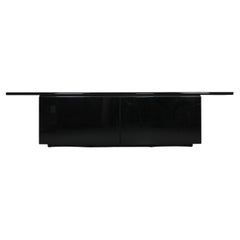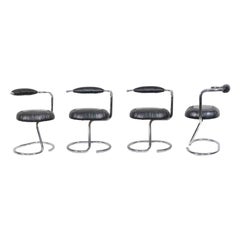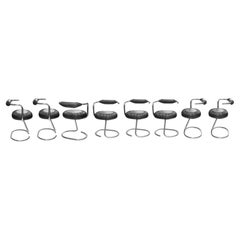
Giotto Stoppino Set of Four Cobra Chairs in Steel and Black Skai 1970s Italy
View Similar Items
Want more images or videos?
Request additional images or videos from the seller
1 of 5
Giotto Stoppino Set of Four Cobra Chairs in Steel and Black Skai 1970s Italy
About the Item
- Creator:Giotto Stoppino (Designer)
- Dimensions:Height: 30.32 in (77 cm)Width: 22.05 in (56 cm)Depth: 21.26 in (54 cm)
- Sold As:Set of 4
- Style:Space Age (Of the Period)
- Materials and Techniques:
- Place of Origin:
- Period:
- Date of Manufacture:1970s
- Condition:
- Seller Location:Montecatini Terme, IT
- Reference Number:1stDibs: LU5304225693932
About the Seller
4.9
Platinum Seller
These expertly vetted sellers are 1stDibs' most experienced sellers and are rated highest by our customers.
1stDibs seller since 2020
103 sales on 1stDibs
More From This SellerView All
- Giotto Stoppino Set of Six White Alessia Chairs by Driade 1970s ItalyBy Driade, Giotto StoppinoLocated in Montecatini Terme, ITSet of six Alessia chairs with legs in tubular chromed metal and seats in white ABS, designed by Giotto Stoppino and manufactured by Driade in the 1970s. (Manufacturer's brand visi...Category
Vintage 1970s Italian Mid-Century Modern Chairs
MaterialsMetal
$2,286 Sale Price / set20% Off - Giotto Stoppino Round Table with Steel Base and Glass Top 1970s ItalyBy Giotto StoppinoLocated in Montecatini Terme, ITA round-shape dining table with a steel base and glass on top, designed by Giotto Stoppino, Italian Manufacture, 1970s. Giotto Stoppino has been one of the architects that inspired ...Category
Vintage 1970s Italian Post-Modern Tables
MaterialsSteel
$1,231 Sale Price20% Off - Giotto Stoppino Sheraton Sideboard in Black Lacquered Wood by Acerbis 1977By Acerbis, Giotto StoppinoLocated in Montecatini Terme, ITSheraton sideboard presents two sliding doors that slide outward to expose three inner storage units with glass shelves and four drawers on the central part. The sideboard has a str...Category
Vintage 1970s Italian Mid-Century Modern Sideboards
MaterialsLaminate, Wood, Ash
- Mario Botta Set of Six 605 Quinta Chairs in Black Lacquered Steel by Alias 1980By Alias, Mario BottaLocated in Montecatini Terme, ITSet of six 605 Quinta chairs with a black steel rod frame seat and back in bent perforated sheet metal. Designed by Mario Botta for Alias in 1985 (This chair is no longer in production). The Quinta chair it's an architecture you can sit on, this design clearly shows the inspiration of iconic designer as Le Corbusier, Louis Kahn, and Carlo Scarpa, an exemplary of this iconic chair is also exhibited at the Museum of Modern Art. Mario Botta was born in 1943 in Mendrisio. After working as an apprentice draughtsman for the Lugano-based architect Tita Carloni, he moved first to Milan and then to Venice, where he enrolled at the department of Architecture at the IUAV. He completed his degree in 1969 with a thesis tutored by Carlo Scarpa – after having met Le Corbusier and Louis Kahn, who were later to be sources of inspiration – and returned to Switzerland to open his own professional firm, which at the time dealt mainly with detached family private homes. These included the villas in Riva San Vitale (1971-1973), Ligornetto (1975-1976) and Morbio Superiore (1982-1983), in which Botta treated the theme of the home as a refuge, which protects and reassures its inhabitants. These were buildings with a character that was ironic and, in a certain sense, monumental, obtained for example (in the case of Morbio) through rigorous symmetrical compositions and a particular use of raw concrete blocks set in a linear pattern and alternated with strips of silvered brick which, on the contrary, were set at 45 degrees. Partially dug into the hillside, the villa was also characterised by a theme which was particularly dear to Botta and which had already been explored in Riva San Vitale; the net distinction between solids and voids, the latter appearing to have been dug out of the building. Between 1980 and 1990, Botta associated with artists and intellectuals from all walks of life and took numerous long trips abroad. Together with Gabriele Basilico and Edoardo Sanguinetti, he published “La Casa Rotonda”, and he became friends with Max Huber, Nicki de Saint Phalle, Dante Isella, Harld Szeemann, Robert Frank and Alberto Flammer. In 1986, the MoMA in New York dedicated a solo exhibition to his work, and the Swiss architect received his first contracts for public buildings and from abroad, debuting with the Cultural Centre in Chambéry (1984-1987). In Japan, on a challenging triangular lot of only one hundred and sixty square metres, a space which remained from the opening of a new highway, Botta built a small building which, with its clarity and strength of image, attempted to stand out in the midst of the chaos that surrounded it, thanks to a thick masonry curtain raised on the main façade, in which slabs of grey marble are crossed with horizontal fissures which erode the angles and cancel the perception of the number of floors which make up the museum. The church of Mongo, on the other hand, was the first step in a long series of places of worship, including designs for the churches of Pordenone (1987-1992) and Sartiana (1987-1995), for the cathedral of Evry (1988-1995), for the basilica of Santa Maria degli Angeli on Mont Tamaro (1990-1996, for the Giovanni XXII church in Seriate (1994-2000) and for the Cymbalista synagogue in Tel Aviv (1996-1998). In each of these, light plays a predominant role as a prime generator of space and a measure for the definition of time that passes with the various phases of the day, the months and the seasons. Light is, however, the main symbolic element, representing through its variations the uneasiness of humankind in the face of divine perfection. In this same period, the scheduling for the construction of a new School of Architecture, the Mendrisio Academy, took place. Inaugurated in 1996, it offered an alternative approach to teaching in contrast to the Swiss University system, in which an important role is played by humanistic subjects and by a copious group of well-known international professors: from Rykwert to Benevolo, Burkhart, Campos Baeza, Dal Co, Frampton, Mendes da Rocha...Category
Vintage 1980s Italian Post-Modern Chairs
MaterialsSteel, Sheet Metal
- Luigi Caccia Dominioni Set of Six Catilina Chairs in Steel and Fabric AzucenaBy Luigi Caccia Dominioni, AzucenaLocated in Montecatini Terme, ITSet of six Catilina chairs with frame in painted steel, seat top in multi-layered wood, and upholstery-shaped polyurethane cushions covered with red fabric. This iconic seat was designed by Luigi Caccia Dominioni, and produced by Azucena since 1958. Luigi Caccia Dominioni firstly presents this seat at the XI Triennale in Milan in 1957 and from this moment Catilina became one of Luigi Caccia Dominioni’s classics. Caccia Dominioni created a new chair and also defined how to sit in it. Catilina is not designed for relaxation and letting go but for thoughtfulness and elegance. You could almost be transported back to ancient Rome ensconced in the seat of the Roman senator, Lucio Sergio Catilina, after whom the chair is named. In turn, the chair harks back to medieval thrones...Category
Vintage 1950s Italian Mid-Century Modern Club Chairs
MaterialsSteel
- Augusto Bozzi Set of Four Ariston Chairs in Plywood and Metal by Saporiti 1950sBy Fratelli Saporiti, Augusto BozziLocated in Montecatini Terme, ITSet of four dining chairs model Ariston with structure in curved plywood and black lacquered metal legs. The Ariston chair was designed by Augusto Bozzi and manufactured by Saporiti...Category
Vintage 1950s Italian Mid-Century Modern Chairs
MaterialsMetal
You May Also Like
- Set of 4 Black Cobra Chairs by Giotto Stoppino, Italy, 1970sBy Giotto StoppinoLocated in Roma, ITSet of 4 Black Cobra Chairs by Giotto Stoppino, Italy 1970s. Chromed tubular steel structure and black leather. 78x49x46 cm. Kg. 30 (set) Good conditions. Giotto Stopp...Category
Vintage 1970s Italian Chairs
MaterialsSteel
- Set of 8 Black Cobra Chairs by Giotto Stoppino, Italy, 1970sBy Giotto StoppinoLocated in Roma, ITSet of 8 Black Cobra Chairs is a set of chairs realized in the 1970s by Giotto Stoppino (Milan, 1926). Chromed tubular steel structure and light blue fabric. This 'Cobra' chair was...Category
Vintage 1970s Italian Chairs
MaterialsSteel
- Set of 14 Black Cobra Chairs by Giotto Stoppino, Italy, 1970sBy Giotto StoppinoLocated in Roma, ITSet of 14 Black Cobra Chairs is a set of chairs realized in the 1970s by Giotto Stoppino (Milan, 1926). Chromed tubular steel structure and light blue fabric. This 'Cobra' chair wa...Category
Vintage 1970s Italian Chairs
MaterialsSteel
- Set of 8 Green Cobra Chairs by Giotto Stoppino, Italy, 1970sBy Giotto StoppinoLocated in Roma, ITSet of 8 Green Cobra Chairs is a set of chairs realized in the 1970s by Giotto Stoppino ( Milan, 1926 ) . Chromed tubular steel structure and light blue fabric. This ' Cobra ' chai...Category
Vintage 1970s Italian Chairs
MaterialsSteel
- Set of Six Cobra Chairs black Leather by Giotto Stoppino, 1970sBy Giotto StoppinoLocated in Roma, ITBlack Cobra chairs is an original set of chairs realized in the 1970s by Giotto Stoppino (Milan, 1926). Chromed tubular steel structure and black leather This 'Cobra' chair was...Category
Vintage 1970s Italian Chairs
MaterialsSteel
- Set of 8 Light Blue Cobra Chairs by Giotto Stoppino, Italy, 1970sBy Giotto StoppinoLocated in Roma, ITSet of 8 Light Blue Cobra Chairs is a set of chairs realized in the 1970s by Giotto Stoppino (Milan, 1926). Chromed tubular steel structure and light blue fabric. This 'Cobra' chai...Category
Vintage 1970s Italian Chairs
MaterialsSteel
Recently Viewed
View AllMore Ways To Browse
Four Black Chairs
Retro Metal And Leather Chair
Used Furniture In Victoria
Set Of Four Black Chairs
Italian Chairs Set Of Four
Unique Metal Chair
Tubular Metal Chair
Set Of Chairs Padded
Tubular Chair Italy
Tubular Italian Chair
Tokyo Used Furniture
Chair Handle
Italian Designer 1960 Chair
Italian Chair Black Chrome
1970a Italian Chair
Chair With Handle
1970s Plastic Chairs
Retro Factory Chair

